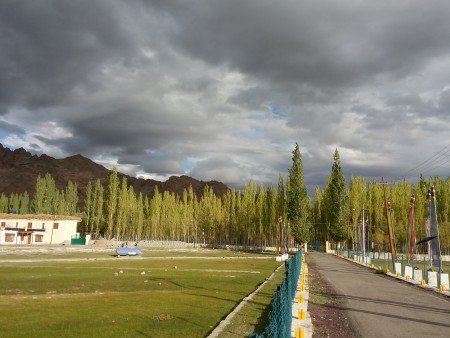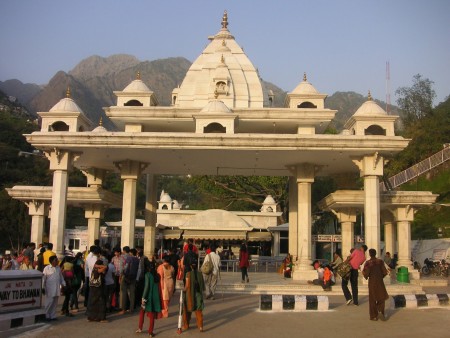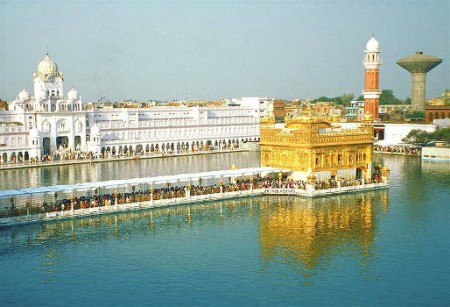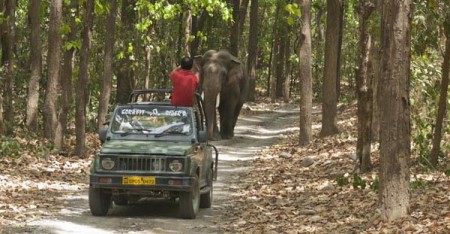
Leh India
Leh is located in the Indus river valley at a crossroads of the old trading routes from Kashgar, Tibet, and Kashmir.
Since opening to tourists in 1974, it has become a bustling tourist town, with large numbers of Kashmiri traders. It's a small town, easy to get most places by foot. The old town is a compact area of mud brick houses and narrow lanes directly to the east of Main Bazar. Changspa is the agricultural "suburb" northwest of the center, with many guesthouses. The main Bazaar's elevation is 3505 meters , so take it easy on your first few days there or risk possible altitude sickness. Even experienced high altitude travellers (Andes) might have some trouble. Travelling in Leh without professional guidance is like shooting for the moon while being too busy gazing the stars. There are various giants offering customized packages that are tailor-made to suit your needs. How to get here: There are two roads in to Leh, one from Manali in Himachal Pradesh in the south, and one from Srinagar in the west. Both routes are equally spectacular in different ways, and both are time consuming with winding, narrow roads, and numerous military checkpoints. The main advantage of taking the road from Srinagar, covering a distance of 434 km (270 mi), is that it runs at a lower altitude, and thereby reduces the risk and severity of altitude sickness. It is also open longer - normally from the beginning of June to October - and follows the traditional trade route between Ladakh and Kashmir, which passes through many picturesque villages and farmlands. The disadvantage is that it passes through areas of higher risk of militant troubles. It takes two long days, with an overnight stop in Kargil. Tickets cost Rupees 370/470 on ordinary/deluxe buses. The route from Manali to Leh, covering a distance of 473 km (294 mi), is one more commonly taken by tourists. It takes two days, normally with an overnight stop either in Keylong (alt. 3096) or in tent accommodation in Sarchu (4253) or Pang (4500). Making the first stop in Keylong drastically reduces the risk of altitude sickness (AMS). It traverses one of the highest road passes in the world and is surrounded by wild rugged mountains. The scenery is fantastic, though it is definitely not for the faint hearted. This historical trade route was linked to Yarkhand and was severed by the India-China war in 1962, and later was transformed in to military supply road. Reliable access is limited from mid-June to end-September, as it is blocked by snow for rest of the year. Clearing of snow on both these roads starts sometime in early April.
More details
Jammu, winter capital of Jammu and Kashmir state in India
Jammu is well connected by train to points south and east. Jammu Tawi is an important railhead of the Norther Railways serving the Jammu and Kashmir State
Buses run around the city to reach from one point to other, though you need to ask people how to reach from one place to other. Jammu is also known as City Of Temples, One can visit Raghunath Temple, Ranbireshwar Temple, Peer Kho Cave Temple, Bawey Wali Mata, Mahamaya Temple. Other Place of interest are Baag-e-Bahu Park, Amar Mahal Museum, Mansar Lake and Fish Aquarium at Baag-e-Bahu. Here, the main bazaars – Vir Marg, Raghunath Bazaar and Hari Market – are famous for Kashmiri handicrafts, traditional Dogra jewellery and various dry fruits, chiefly walnuts (‘akhrot’) and almonds. Jammu is also known for the superlative quality of its ‘basmati’ rice, ‘rajma’ (red beans), ‘ampapar’ (dried and candied mango peel), ‘anardana’ (dried pomegranate seeds) and ‘barfi’ (milk sweets). Jammu has an airport which desperately needs modernization but still has many flights from Delhi, Srinagar and Leh. Spice Jet, Air India and Goair have flights from Delhi. Jammu lies on the National Highway 1-A and is connected by national highway network to all parts of the country. Amritsar - 243 kms, Chandigarh - 436 kms, Delhi - 586 kms., Katra - 48 kms, Srinagar - 305 kms, Manali - 428 kms, Patnitop - 112 kms. Mansar - 60 kms.
More details
Kashmir
Northern tourist place of India. Surrounded by mountains and big lake with pleasant weather. This is number 1 in list for honeymoon goers.
A jewel of a destination, Kashmir is one of the most amazing holiday destinations in India. Srinagar, the state's winter capital, capital, is the first stop for most travelers to Kashmir; and with its great lake and meandering river, its exquisite pleasure gardens and romantic shikara rides, the old-world charm of its houseboats and the ageless grace of its architecture, the city is a fitting introduction to the many enchantments of the valley. The vast Dal lake is, of course, Srinagar's emblematic feature , and its deep waters carry the most popular of Srinagar's attractions: houseboats and shikaras. Many visitors are content to spend a great part of their holiday aboard these waterborne hotels, watching the lake's traffic float by from cushioned balconies, venturing into the houseboat's walnut-wood interiors for delicious, fragrant Kashmiri cuisine. If at all one can bring oneself to leave the boat, it is to step into another - the dainty, canopied shikaras.Other like Places Leh, Ladakh, Patnitop, Vaishno Devi, Shimla, Manali, Dalhousie, Mont Abu, Mussoorie, Nainital, Dehradun, khajjiar, Gulmarg, Dharamshala, Lansdowne, Darjeeling, Gangtok, Shilong, Khandala, Lonawala, Mahabaleshwar, Panchgani, Panhala, Saputara , Munnar, Aruku Valley, Coonoor, Coorg, Devikulam, Kodaikanal, Ooty, Nandi Hills

Shimla - Himachal Pradesh (India)
One of many tourist places of Hilly state of India, Himachal. Tourists throng this place whether it is summer or winter.
Shimla is a beautiful hill station in Himachal Pradesh, well known among vacationers for family tours, honeymoon tours, and holidays. It is the best place for the summer holidays in India. Situated in the lower ranges of the Himalayan mountains, surrounded by pine deodar, oak, and rhododendron forests. Towards the north lie the snow-covered high-ranges, while the valleys breathe whispering streams and swaying fields. Within the town are a host of splendid colonial edifices, quaint cottages, and charming walks. Shimla offers a variety of shopping, sport, and entertainment activities. Places Like this Srinagar, Pahalgam, Leh Ladakh, Manali, Dalhousie, Chamba, Kufri, Dharamshala, Mcleodganj, Munnar, Nainital, Rishikesh, Mussoorie, Gangtok, Tawang, Ziro, Morni Hills, Saputara, Mount Abu, Lonavala, Mahabaleshwar, Thekkady, Darjeeling, Shilong, Coorg, Ooty, Kodaikanal, Khandala, Kasauli, Coonoor, Matheran, Wayanad, Cherrapunjee, Kohima, Namchi, Pelling, Yelagiri, Auli, Almora, Tawang

Golden temple - most religious place of sikhism
Golden temple also called as Harmandir Sahib, located in the city of Amritsar, Punjab, India. People from all over world visit this place to pay homage to Gurus of Sikhism
Golden Temple, is the holiest Sikh gurdwara located in the city of Amritsar, Punjab, India. There are four doors to get into the Golden Temple (Harmandir Sahib), which symbolize the openness of the Sikhs towards all people and religions. The present- day gurdwara was rebuilt in 1764 by Jassa Singh Ahluwalia. In the early nineteenth century, Maharaja Ranjit Singh secured the Punjab region from outside attack and covered the upper floors of the gurdwara with gold, which gives it its distinctive appearance and its English name. Other Spiritual Places - Vaishno Devi, Amarnath Yatra, Badrinath, Dharmshala, Chamunda, Namchi, Chintpurni, Kangra, Jwalaji, Yamunotri, Kedarnath, Haridwar, Vrindavan, Mathura, Rishikesh, Dilwara temple, Varanasi, Gangotri, Joshimath, Shirdi. Rameswaram, Kanyakumari, Madurai, Hampi, Rameshwaram, Velankanni Church, Somnath, Ellora, Prayag, Ajmer Sharif, Ranakpur Temple, Bahubali, Velankanni Church, Shirdi, Somnath Jyotirlinga, Jagannath Temple, Sun Temple, Tirupati, Bodhgaya

Jim Corbett National Park
Jim Corbett National Park is situated in the foothills of the Himalayas, in the newly created state of Uttarakhand is haven for wildlife lovers in India
The present area of the Corbett national park is 1318.54 sq. km. including 520 sq. km. of the core area of 797.72 sq. km. of buffer area. The core area of the Corbett tiger reserve forms the Corbett National Park while the buffer contains reserve forests (496.54 sq.km.) as well as the Sonanadi Wildlife Sanctuary (301.18 sq.km.) Flat valleys are interspersed with hilly ridges and the Park's rolling grasslands provide an excellent view of its rich ecosystem. Places like this. Kaziranga National Park, Gir National Park, Ranthambore National Park, Bandhavgarh National Park, Bandipur National Park, Idukki, Chinnar, Parambikulam, Parambikulam Wildlife Sanctuary, Peppara Wildlife Sanctuary, Wayanad Wildlife Sanctuary, Aralam Wildlife Sanctuary, Mangalavanam Bird Sanctuary, Thattekad Wildlife Sanctuary, Dachigam Wildlife Sanctuary, Sunderbans Wildlife Sanctuary, Manas Wildlife Sanctuary, Bharatpur National Park, Kanha National Park, Periyar Wild Life Sanctuary, Vedanthangal Bird Sanctuary, Sariska National Park, Mundanthurai Wildlife Sanctuary, Annamalai Wildlife Sanctuary, Campbell Bay National Park, Dudhwa National Park, Nanda Devi Biosphere Reserve, Hemis National Park, Kanchendzonga National Park, Dandeli Wildlife Sanctuary, Harike Wetland

Jaipur
City of Western state of India with beautiful palaces, dessert safari, lakes and hills.
The Pink City is replete with historical landmarks that echo its past glory and living traditions. Discover palaces and forts, temples and gardens, crafts, and pageantry here. City Palace: Built by Sawai Jai Singh, it became the official seat of the Jaipur royal family after 1922. Jantar Mantar: Built-in 1728, it is one of Sawai Jai Singh's unique observatories. Hawa Mahal: Also called the "Palace of Winds" was built in 1799. It is an unusual five-storeyed structure with a facade of extensive latticework in stone. Amer Fort: It is one of the finest and the best-preserved forts, having served as the royal capital for seven long years before the city of Jaipur was built. It has a complex of several palaces, meeting halls, pavilions, gardens, and temples. Places like this: Taj Mahal, Mysore Palace, Victoria Memorial, Charminar, Sanchi Stupa, Qutab Minar, Gateway of India, Vidhana Soudha, Agra Fort, Brihadisvara Temple, Fatehpur Sikri, Jaipur City Palace, Jaisalmer Fort, Jama Masjid, Kanheri Caves, Khajuraho, Red Fort, Sun Temple of Konark, The Lucknow Residency, Khajuraho, Golden Temple, Dilwara Jain Temples, Ajanta Caves, Ellora Caves, Kanyakumari, Mysore Palace

Goa India
Goa, situated on the west coast of India, is one of the most delightful states in India
Formerly a Portuguese colony, it is endowed with a variety of attractions, like palm pronged beaches, miles of golden sands, lush green countryside, an incredible mosaic of cultural heritage, magnificent churches, temples, forts, and monuments, and a unique cultural synthesis of the east and west. With its tropical climate, Goa is a tourist destination for all seasons. Places Like this. CHOWPATTY BEACH(MUMBAI), Palolem Beach(Goa), Baga Beach(Goa), Arambol Beach(Goa), Varca Beach(Goa), Agonda Beach(Goa), Cavelossim Beach(Goa), Mandrem Beach(Goa), Cola Beach(Goa), ULLAL(MANGALORE), KUDLEE BEACH(KARNATAKA), Kovalam Beach(Kerala), Varkala Beach(Kerala), Marari Beach(Kerala), Lighthouse Beach(Kerala), Radhanagar Beach(Andaman Nicobar Islands), Tarkarli Beach(Malvan), Bangaram Island Beach(Lakshwadeep), Puri Beach(Odisha), MARINE PARADE(ODISHA), Rishikonda Beach(Andhra Pradesh), THE MARINA(CHENNAI)

Vaishno Devi, Katra (India)
Vaishno Devi, the Most Famous Goddess Shrine in the Jammu Katra (J&K, India)
Vaishno Devi, also known as Mata Rani, Trikuta, Ambe and Vaishnavi, is a manifestation of The Hindu Mother Goddess, Devi. The words "Maa" and "Mata" are commonly used in India for mother, and thus are often heavily used in connection with Vaishno Devi. Goddess Vaishnavi was formed from the combined energies of Goddess Parvati/Mahakali, Mahalakshmi, and Mahasaraswati. Vaishno Devi Mandir is a Hindu temple located in Katra at the Trikuta Mountains within the Indian State of Jammu. The Temple is a Trek of 13Km from Basecamp of Katra to Bhavan and various modes like Pony, Helicopter, and ropeway are now available for the ease of devotees, however, it is still recommended to climb the trek by foot. Ever since the inception of the Shrine Board in 1986, the Holy Shrine of Mata Vaishno Devi has witnessed an ever-increasing number of devotees. The Yatra that stood at 13.96 Lakhs in the year 1986, increased to 104.95 lakhs (10.4 Million) in the year 2012, 93.24 Lakhs in the year 2013, 78.03 Lakhs in the year 2014, 77.76 Lakhs in the year 2015, 77.23 Lakhs in the year 2016 and 85.87 Lakhs in the year 2018. Tourists and pilgrims can avail the free of charge Dharamshala facility available around the main shrine area. Payment of a nominal sum for the upkeep of the Dharamshala is appreciated, but not imposed. Hotels and guest houses are available in sufficient numbers at the base camp in Katra. Make sure you make prior bookings, more so, if you are making a trip during peak season between April to September.